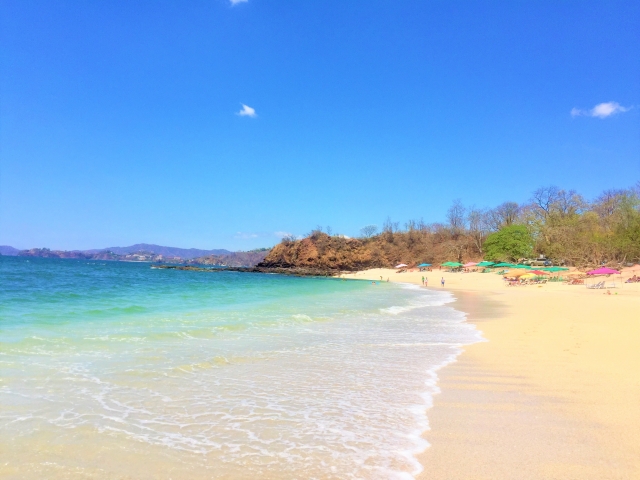Hello, this is colorful beans.
How has everyone been involved with coffee? A simple cup of coffee ☕️ that we casually enjoy.
Behind that cup lies a magnificent history and culture.
I would like to introduce that background and bring a new breeze to everyone’s coffee life.
With that goal in mind, today I would like to introduce Costa Rica.

Costa Rican coffee history
First, let’s check the location of Costa Rica.


Located between Mexico and Colombia, and close to Guatemala, Costa Rica is known for its coffee cultivation.
In 1821, Costa Rica gained independence from colonial rule. To achieve economic self-sufficiency, the country focused on coffee cultivation. In the largest city of Costa Rica, San Jose, residents were given land and coffee seedlings to promote coffee farming.
On Costa Rican farms, they also cultivated food crops alongside coffee to sustain themselves. These practices have undoubtedly influenced the taste of Costa Rican coffee.
The presence of various trees, crops, and fruits near coffee trees can influence the development of coffee cherries and contribute to the flavor profiles and nuances of the coffee.
Situated between the Caribbean Sea and the Pacific Ocean, Costa Rica boasts a diverse geography characterized by a volcanic belt that spans across the country, creating varying elevations. Approximately 40% of the land is covered by tropical rainforests, providing an ideal environment for coffee cultivation.
In 1933, the Costa Rican Coffee Institute (ICAFE) was established. It is an organization dedicated to the production, maintenance, and improvement of coffee quality in Costa Rica.
The Costa Rican Coffee Institute (ICAFE) provides guidance on cultivation, processing techniques, export management, and environmental conservation efforts.
Costa Rica places a strong emphasis on quality and has pursued differentiation from other countries. One policy that supports this approach is a law enacted by the government in 1988, which prohibits the production of any coffee variety other than Arabica. This law remains in effect today, ensuring that Costa Rica maintains its high-quality standards, with specialty coffee accounting for about half of its production.
Costa Rica’s productivity is considered to be superior and sets the pace for other countries in the industry.
Cultivation methods and environment in Costa Rica
Let’s explore the cultivation methods and environmental aspects of coffee in Costa Rica.
Coffee cultivation in Costa Rica primarily takes place at elevations ranging from 1000 to 1700 meters, accounting for approximately 75% of the production. The high elevation contributes to the development of flavorful coffee cherries due to the significant temperature differences between day and night.
Costa Rica experiences distinct rainy and dry seasons, providing an ideal climate for coffee tree cultivation. Being located near the equator, the country benefits from ample sunlight. However, it is not simply a matter of having abundant sunlight.
To avoid exposing the coffee trees to direct sunlight for extended periods, shade trees (tall trees) are strategically planted to provide moderate shade. This helps create a suitable shaded environment for the coffee trees while still allowing them to receive adequate sunlight.
In 1970, a technological revolution brought significant changes to the coffee industry in Costa Rica.
The introduction of agricultural chemicals played a major role. This led to a reduction in shade trees and the adoption of high-yielding new coffee varieties, resulting in a substantial increase in harvest volumes.
By 1960, it is said that coffee production had expanded threefold compared to previous years, allowing for the selective export of even higher-quality coffee.
Costa Rica’s volcanic belt provides fertile soil enriched with volcanic ash, creating optimal conditions for cultivation. The soil containing volcanic ash is rich in minerals and has excellent water retention capacity, providing a suitable environment for coffee tree cultivation and ensuring the presence of essential nutrients.

Commitment to high quality!
Costa Rica has prioritized quality and maintained its production without entering into the low-price competition with Brazil, the world’s largest coffee producer. Instead, Costa Rica has focused on producing high-quality coffee and received great recognition from Europe.
In the 1920s, coffee exports experienced a significant increase. After World War II, Costa Rica shifted its major export market from Europe to the United States, playing a crucial role in stimulating the country’s economy.
Costa Rica has placed a strong emphasis on quality and specialized in the production of high-quality coffee, refraining from engaging in low-price competition with Brazil, which has earned them high praise from Europe.
In the 1920s, coffee exports experienced a sharp increase. After World War II, Costa Rica shifted its primary export market from Europe to the United States, playing a vital role in revitalizing the country’s economy.
Production area and refining method
In Costa Rica, the production methods and processing techniques are adjusted according to the climate and environment of each region, leading to regional variations in the taste of coffee.
Coffee cultivation takes place in seven different regions in Costa Rica, with specific coffee varieties chosen to match the environmental conditions of each region. The Catuai variety is commonly grown in regions below 1000m in altitude, while the Catucaí variety is more prevalent in higher-altitude regions above 1200m.
Although the sizes of individual farms may differ, they are generally not very large, allowing for meticulous care and cultivation of each coffee tree.
This attention to detail contributes to the cultivation and harvest of high-quality coffee beans in Costa Rica.
Now, let’s talk about the processing method, specifically the unique Honey Process in Costa Rica. This is a highlight worth mentioning.
First, the process of extracting green beans from coffee cherries is called processing.
There are various processing methods such as Natural, Washed, and Pulped Natural.
Among these methods, the unique processing method in Costa Rica is called the Honey Process.
While there are several processing methods, the common goal is to remove the mucilage (also known as “miel” or “honey”). This step is similar across most methods except for the Honey Process.
In the Honey Process, the coffee cherry’s mucilage is intentionally left intact, allowing the sugars to concentrate in the beans.
The terminology used to describe the Honey Process varies depending on the proportion of mucilage left on the beans.
- Black Honey: 100% and high sugar content cherry.
- Red Honey: 100%.
- Yellow Honey: 50%.
- White Honey: 0%.
While they are considered rare beans that are not easily accessible, it doesn’t mean they are shipped with the pulp (mucilage) still intact.
The mucilage is left intact during the drying process, and then after subsequent steps such as threshing, the green beans are extracted and exported. Therefore, it is difficult to visually differentiate them from other beans just by looking at the green beans.
Personally, I have only experienced up to Yellow Honey, but it results in a coffee flavor with a significant impact. I vividly remember being pleasantly surprised by the taste that I had never experienced before.
Given the opportunity, I would like to roast Black Honey and Red Honey as well, and also try the coffee made from them.

Coffee extraction and how to enjoy
Costa Rican coffee is delicious even without the Honey Process.
I believe that the differences in extraction methods can also have a significant impact on the flavor.
If possible, I would recommend experiencing the taste of Costa Rican coffee directly through a French press and then exploring different brewing equipment and methods such as pour-over or siphon to further enjoy its flavors.
In that regard, I would like you to further refine the extraction using the method you find most suitable, allowing you to fully savor the intricate flavors of Costa Rican coffee.
With a light roast, you can expect a distinct acidity, bright fruity notes, and a subtle hint of sweetness.
A medium roast brings out a softer acidity, enhanced sweetness, and deeper flavors.
For a medium-dark roast, you’ll experience a smooth mouthfeel, captivating aroma, a balance of sweetness and hidden acidity, and a lingering aftertaste.
There are various ways to enjoy Costa Rican coffee.
May you find your preferred flavor profile.
May you encounter tastes that are unlike anything you’ve experienced before.
May a new breeze sweep into your coffee life.
Thank you for reading this far.




コメント